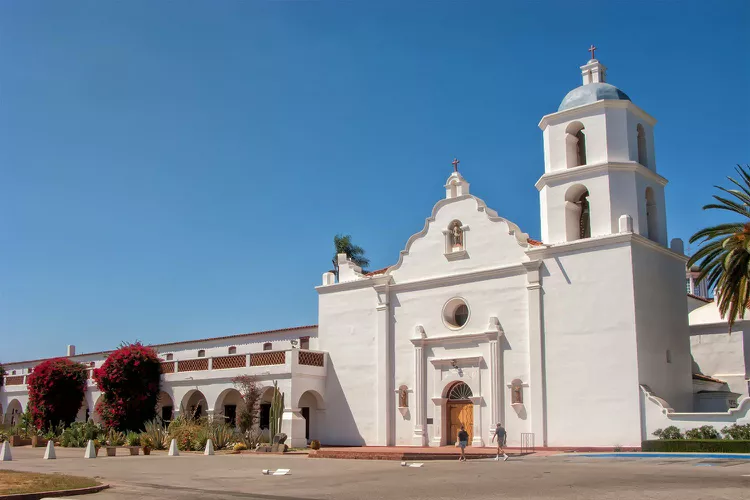Summary
Mission San Luis Rey de Francia was the eighteenth one built in California, founded June 13, 1798, and was the last California mission founded by Father Fermin Lasuen. It was named for Louis, King of France (Mission San Luis Rey de Francia).
Mission San Luis Rey Timeline
- 1798 – Father Lasuen founds Mission San Luis Rey
- 1821 – First church finished
- 1831 – 2,800 native converts
- 1832 – Father Peyri leaves Mission San Luis Rey
- 1834 – Secularized
- 1892 – Franciscans return to Mission San Luis Rey
- 1895 – Reconstruction begins
The mission is north of San Diego in Oceanside. You can find the address and hours at the Mission San Luis Rey website.
History of Mission San Luis Rey de Francia: 1798 to the Present Day
:max_bytes(150000):strip_icc():format(webp)/5524771209_4972e385c7_o-57d6103e3df78c58336107d2.jpg)
San Luis Rey Mission was founded on June 13, 1798, by Father Fermin Lasuen. It was number eighteen out of twenty-one missions.
Early San Luis Rey Mission History
Father Lasuen chose the San Luis Rey Mission site due to the presence of amicable natives and the commendable soil. Under the guidance of Father Antonio Peyri, who remained for over thirty years, the mission flourished, becoming the most productive of all the California missions.
The natives were eager to work and accepted baptism readily. Consequently, within two years, they constructed adobe bricks, numerous tile-roofed buildings, and commenced work on a substantial church accommodating 1,000 worshippers.
San Luis Rey Mission History in the 1820s -1830s
By 1821, the first church was completed. Remarkably, just six years post-establishment, San Luis Rey was yielding 5,000 bushels of crops annually and boasted herds exceeding 10,000 animals. The Padres instructed the natives in various crafts, including candle-making, tanning, winemaking, weaving, agriculture, and ranching, also involving them in choir practices.
San Luis Rey Mission peaked in 1831, with records indicating 2,800 natives residing there, generating 395,000 bushels of grain and a vineyard that produced 2,500 barrels of wine.
Secularization and San Luis Rey Mission
After 34 years of service, Father Peyri retired in 1832, fearing the consequences of secularization. Following his departure, the decline set in. While the natives endeavored to preserve the mission, their efforts proved futile. Ultimately, in 1846, Mexican Governor Pio Pico sold the San Luis Rey Mission buildings for $2,427, far below their estimated value of $200,000.
The natives relocated to reservations at Pala, where they remain. For a time, the U.S. Army occupied the San Luis Rey site; however, neglect ensued until its return to the Catholic Church in 1865. After a period of dormancy, the Franciscans returned in 1892, leading to rededication in 1893 and reconstruction starting in 1895.
San Luis Rey Mission in the 20th Century
By 1905, owners had completed sufficient reconstruction for the Franciscans to return. The lavanderia (laundry) and surrounding gardens were uncovered in 1959, reviving interest in this historic site.
Today, the San Luis Rey Mission operates as a vibrant parish church.
Mission San Luis Rey Layout, Floor Plan, Buildings and Grounds

The original church at Mission San Luis Rey de Francia was designed to accommodate 1,000 worshippers. Completed in 1802, it incorporated adobe brick and featured a tile roof.
By 1811, the mission was expanding; consequently, Father Peyri initiated plans for a new church, which stands today. The church measures 180 feet long, 28 feet wide, and 30 feet high.
Jose Antonio Ramirez arrived from Mexico to impart construction skills to the local natives for the new church. Completed and dedicated on October 4, 1815, it was constructed with adobe, lime plaster, wooden timbers, fired clay bricks, and roof tiles.
The church exhibits a style known as Spanish Colonial, merging Baroque and Classical elements. Work on the church continued for an additional ten years.
By 1826, the quadrangle measured 500 feet on each side. In front, the convento extended 600 feet with 32 arches, providing quarters for priests and visitors. The mission also featured an infirmary, women’s quarters, storage rooms, workspaces, orchards, and outdoor gardens. Interestingly, the oldest pepper tree in California, introduced from Peru around 1830, remains in the quadrangle.
Laundry at San Luis Rey
:max_bytes(150000):strip_icc():format(webp)/PA240049-1000x1500-57d60c633df78c583360ec24.jpg)
In front of the mission, an open-air laundry (lavanderia) and sunken garden exist. Water flows from two springs through open-mouthed gargoyles (stone faces) into a bricked area for laundry activities. This water subsequently enters an irrigation system supporting exotic plants and orchards, complete with a charcoal filter purification system to ensure the drinking supply remains clean.
Cattle at Mission San Luis Rey

In 1831, the mission managed a herd of 16,000 cattle and 25,500 sheep. The displayed image features the Mission San Luis Rey brand, taken from samples shown at Mission San Francisco Solano and Mission San Antonio.
Mission San Luis Rey Interior Picture

Currently, the mission has been restored and repainted to align with images of its original interior. The Stations of the Cross adorning the walls were painted specifically for Mission San Luis Rey in Mexico during the 1780s.
The original wooden pulpit, the only remaining wooden structure untouched by termites, is preserved to this day.
Regrettably, the original reredos behind the altar was destroyed by treasure-seekers, and efforts to recreate it have ceased due to the absence of original drawings or photographs.





